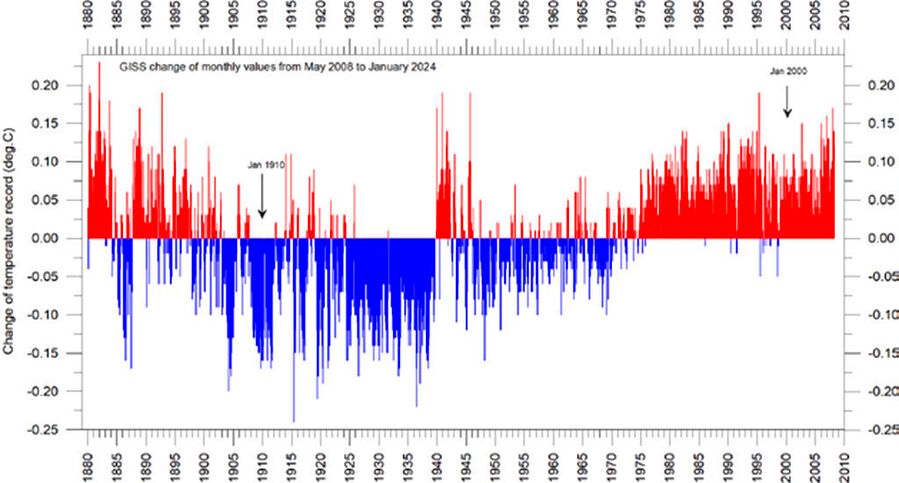
© Shutterstock
In his recently published 2023 climate report, Humlum notes that clearly such adjustments are important when evaluating the overall quality of the various temperature records. But such 'evaluation' is entirely missing from most mainstream media and science. It would seem they are afraid to question organisations such as the U.K. Met Office which collect corrupted data from unsuitable monitoring sites and regularly adjust the records on a retrospective basis. The lack of investigative inquiry points to the central role that temperatures play in terrifying populations to accept the appalling lifestyle changes needed to achieve Net Zero in less than 30 years.
If the adjustments showed rises and falls spread evenly throughout the record, suspicions about the practice would be considerably less. But almost invariably the changes cool a past period and warm the subsequent record to the present day. Humlum provides the graph below to show the accumulated effect of administrative changes made since May 2008 to the GISS global surface air temperature record, which extends back to 1880. The blue lines show where historic temperature measurements have been adjusted downwards and the red lines where they have been adjusted upwards, just in the last 16 years.

© Professor Ole Humlum
Emeritus Professor Ole Humlum is a distinguished physical geographer and his annual climate report is a welcome antidote to the politicised and biased narrative found in the mainstream. He notes that the complex climate has remained in a quasi-stable condition within certain limits for millions of years.
"Modern observations show that this normal behaviour is also characterising recent years, including 2023, and there is no observational evidence for any global climate crisis."Believing that one minor constituent of the atmosphere, carbon dioxide, controls nearly all aspects of climate is "naïve and entirely unrealistic", he adds.
The great service that Humlum does every year is to put recent weather and climate events into much needed perspective. Arctic air temperatures have increased since 1979, but Antarctica recordings have remained essentially stable. The largest warming of the oceans at about 0.2°C is in the upper 100 metres, and mainly in the regions near the equator where the influence of the sun is most pronounced. Since 2004, the northern oceans between 55°-65°N have, on average, experienced a marked cooling down to 1,400m, and slight warming below that. Across the globe, the upper 1,900m of the ocean has seen net warming of about 0.037°C.
Global precipitation varies widely across the planet, from one year to the next and from decade to decade, "but since 1901 there has been no clear overall trend". Storms and hurricanes display variable frequencies over time, but without any clear global trend towards higher or lower values. Global snow cover has remained "essentially stable" from the start of the satellite observation era in 1979, although with important regional and seasonal variations. Global sea ice extent has been quasi-stable since 2018, "perhaps even exhibiting a small increase". Air temperatures in 2023 were noted to be the highest on record - since 1850, 1880 or 1979, according to the particular data series - but recent warming is not symmetrical and is mainly seen in the northern hemisphere.
To conclude, it might be added that the northern hemisphere is where a lot of the naturally warmer land is to be found, and where many of the urban-heat-corrupted, and frequently boosted, temperature measurements are sourced.
Chris Morrison is the Daily Sceptic's Environment Editor.
Source link

